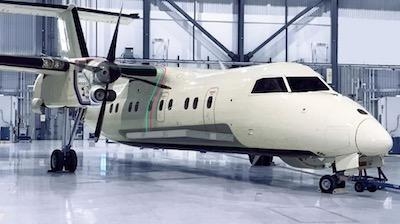Fri, Mar 29, 2019
'Project 804' Based On A Bombardier Dash 8 Airframe
United Technologies has released a white paper detailing what it calls "Project 804", the development of a hybrid-electric airliner.

The plane is an initiative of UTCs newly-established United Technologies Advanced Projects (UTAP)—a startup-like organization at the heart of UTC that disrupts from within. UTAP moves at intense speed to build and pilot ambitious product and service demonstrators, while simultaneously distilling UTC’s curious and collaborative culture.
The Project 804 X-plane will be based on a Bombardier Dash 8 Series -100 aircraft, re-engined on one side with a 2 megawatt-class propulsion system. Its configuration will consist of an engine optimized for cruise efficiency augmented by a battery-powered electric motor to assist during the missions’ 20-minute take off and climb.
The engine and electric motor will each generate about 1 megawatt of power in a parallel hybrid configuration. While the battery cells are off-the-shelf, the packaging and battery management system (BMS) are custom-designed for efficiency and to meet necessary safety requirements. This approach could be suitable for a clean-sheet regional design as well as a retrofitted option for existing airframes. The demonstrator’s novel architecture is expected to provide an industry-leading total fuel savings of at least 30% during an hour-long mission, with some of the fuel savings attributable to the latest in engine technology, not just the added electrification.
UTC believes the electrification of flight represents a significant opportunity for the industry, air travelers and the environment. By combining UTAP’s bold, risk-tolerant approach with UTC’s industrial roots and engineering expertise, Project 804 will make hybrid-electric flight a commercial reality with efficiency and speed.
According to the paper, a regional turboprop requires high take off power to carry large payloads but flies relatively slowly under relatively low power. Project 804 leverages this large ratio between peak power and steady-state power to create significant total energy savings. The propulsion system uses a 50/50 power split, parallel-hybrid configuration between an engine and an electric motor. The electrical assist is high-power and short-duration allowing the size and weight of the energy storage device to be manageable within the aircraft maximum takeoff weight. The configuration also allows the engine to be optimized for the cruise portion of the flight only. Full system capability is within the 2MW power class for the 30-50 passenger regional turboprop market.
(Image from UTC White Paper)
More News
Its Offerings Are Lighter, Cleaner, and Now Pushing Past 1,000nm on SAF Jet Fuel DeltaHawk’s diesel-powered aircraft lineup has seen incredible upgrades over the last few yea>[...]
The Airplane Experienced A Total Loss Of Engine Power On December 3, 2025, about 1600 central standard time, a Mooney Aircraft Corp. M20K, N57229, was substantially damaged when it>[...]
Make Sure You NEVER Miss A New Story From Aero-News Network Do you ever feel like you never see posts from a certain person or page on Facebook or Instagram? Here’s how you c>[...]
Aero Linx: European Society of Aerospace Medicine (ESAM) As a pan-European, independent forum, it works to promote the safety and health of all persons involved in aviation and spa>[...]
“We are excited to see Wisk achieve this milestone, and I’m so proud of the team that made it possible. The team at Wisk has built advanced technologies across flight c>[...]
 Aero-TV: DeltaHawks Diesel Power Steps Into the Spotlight
Aero-TV: DeltaHawks Diesel Power Steps Into the Spotlight NTSB Prelim: Mooney Aircraft Corp. M20K
NTSB Prelim: Mooney Aircraft Corp. M20K ANN FAQ: Turn On Post Notifications
ANN FAQ: Turn On Post Notifications ANN's Daily Aero-Linx (12.20.25)
ANN's Daily Aero-Linx (12.20.25) Aero-News: Quote of the Day (12.20.25)
Aero-News: Quote of the Day (12.20.25)



